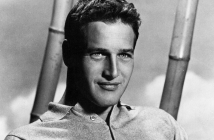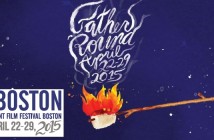Toronto is the place to be during World Pride. With a parade that generates thousands of visitors and endless events during one week in the year, it’s refreshing to see attention being paid to great impact queer cinema has had on the cinema.
Curated by Noah Cowan and Kathleen Pirrie Adams, the Queer Outlaw Cinema Exhibit at the Bell Lightbox is a first of its kind in Canada.
Noah Cowan: “Since TIFF Bell Lightbox has been formed we’ve been interested in the intersection of film and visual art culture and where contemporary filmmakers sit on that trajectory. A lot of LGBTQ artists who love this play between film, video installation, and other kinds of art practice. We take as a leaping point, the great filmmaker Derek Jarman who in many ways created a contemporary queer aesthetic.“
Derek Jarman was a highly influential filmmaker and author who through his honest experimental super 8 mm shorts, created a basis for the groundbreaking homosexual narrative.
Noah Cowan: “He also did a post-modern where he went back through a history of painting and queered it up with things like Caravaggio and The Angelic Conversation.”
Through the AIDS crisis and his own personal struggles with it, Jarman continued to provide evidence of a queer dialogue that used to be taboo. The Queer Outlaw Cinema showcases Jarman’s short film Imagining October (with a haunting soundtrack provided by Genesis P-Orridge). Further inside, the exhibit features a TIFF commissioned work by Scott Treleaven. It’s a film based on encounter with Treleaven had with Jarman, a collection of moving images denoting unique perspectives on memory and how emotions can help one deal with that memory.
Urike Ottinger, a contemporary of Derek Jarman, takes us further into a visual conversation about gender, existence, and acceptance in a world of neglected differences. She has two films in the exhibit: Superbia – The Pride ( a military carnival-esque film) and the entirety of Freak Orlando, a retelling of Virginia Woolf’s masterpiece.
Kathleen Pirrie Adams: “Accompanying the workbooks that relate to the films are these many edges that are taken from Urike Ottinger’s Berlin era films and those range from 1973-1986. She’s still based in Berlin, but really focused on that locale and the culture and the community she participated in in that early period. It’s from there where she drew and developed this representation of queer sensibility.
Pulling in the Jarman influence is Issac Julien with his two screen tribute to Jarman’s The Garden. Utilizing Super-8 footage, Julien creates an activist/rebellious foundation and paints it with beautifully rendered scenes of isolation and despair. Jarman’s long time muse, Tilda Swinton appears and bears witness to the tale.
TIFF also pays tribute with a retrospective of Toronto’s own filmmaker Bruce LaBruce. His impact, in not just marrying pornography and genre cinema, but in molding a unique space for provocative discourse, is strongly felt in many areas of experimental film today.
I had a chance to talk to LaBruce right after my tour of the exhibit.
Bruce LaBruce: “Queer Outlaw is like a credo I had when I was a young queer punk Being homosexual was criminal and you embrace it, rather than shy away from it. I don’t think it’s been lost in terms of queer artists. I think the larger movement, the gay movement, has become increasingly conservative and assimilation sometimes entails disassociating itself from its more extreme and unruly elements, which I think is sad. It goes against the roots of queer activism. This is why this work is so important in the context of the avant garde practice of this continued expression of outlaw identity and otherness and mapping the body as a kind of queer space. “
For me, porn stars and transsexuals are the last gay radicals that remain.
My contribution to this show is all based on collaborations with transsexuals. For me that is one of the more interesting and revolutionary aspects of queer culture.”
Jacqueline: “Have you ever been interested in doing some big budget cinema with little financial limits?”
Bruce LaBruce: “For me, it’s not about budgets; it’s about the work itself. I’ve made two films that came out at the same time: Gerontophilia (which will be released on July 4th Canada-wide), which was a relatively big budget film; and Pierrot Lunaire which was low budget. But it’s all the same to me.
Pierrot is getting a surprising life that we didn’t expect. It’s been getting screened at film festivals. So for a fifty two minute avant garde opera it’s getting around.”
Jacqueline: “What inspires you to still create new provocative works?”
Bruce LaBruce: “Well, you know, I’m a contrarian. I’m always going against the grain. Even within the alternative, I’m always an outcast among outcasts.
As the gay movement becomes more and more mainstream, I’m continually pushing back, and trying to make provocative work that is politically incorrect. I want to keep making works that express difference because the sad thing about assimilation is that is discourages difference.”
Jacqueline: “Or acceptance?”
Bruce LaBruce: “I’ve never been big on acceptance or tolerance, those kinds of words which imply a sort of capitulation to the dominant ideology. It’s about expressing difference, otherness, and celebrating your outlaw status, going against the grain of any orthodoxy. I continue to do that and will continue hopefully even with bigger budgeted projects and/or art projects.”
Jacqueline: “Will there be any more zombies?”
Bruce LaBruce: “Maybe! I mean, I’ve been threatening to finish off my trilogy, but I kind of left it for now.
The new film I’m working on now is called Twincest. Like Gerontophilia, it’s about a fetish. I’m on a tangent of exploring these fetishes that are considered taboo.”
Considering that the world is still debating, still questioning, and still struggling through an acceptance of differences, Queer Outlaw Cinema is an important and long overdue appreciation of cinema’s LGBTQ community. It seems like a work of love for its curators and as such, a must see during its run.




